Evidence-Based Practices: Data Measurement for Effective Decisions
VerifiedAdded on 2023/06/08
|11
|1426
|278
Report
AI Summary
This report explores the application of evidence-based practices within organizations, emphasizing data's importance in driving improvements and informing effective decision-making. It distinguishes between qualitative and quantitative data, highlighting their respective roles in HR functions such as performance appraisals and employee demographics. The report discusses how organizational policies and procedures guide decision-making, ensuring consistency and equity, with HRIS exemplified as a modern decision-making tool. It differentiates between internal and external stakeholders, underscoring the importance of creating value for both through initiatives like fair compensation and career development. The role of people professionals in fostering open communication, leveraging social media, and maintaining customer-centric approaches is also examined. Finally, the report references academic sources to support its analysis of these practices and their impact on organizational performance and stakeholder satisfaction. Desklib provides solved assignments for students.
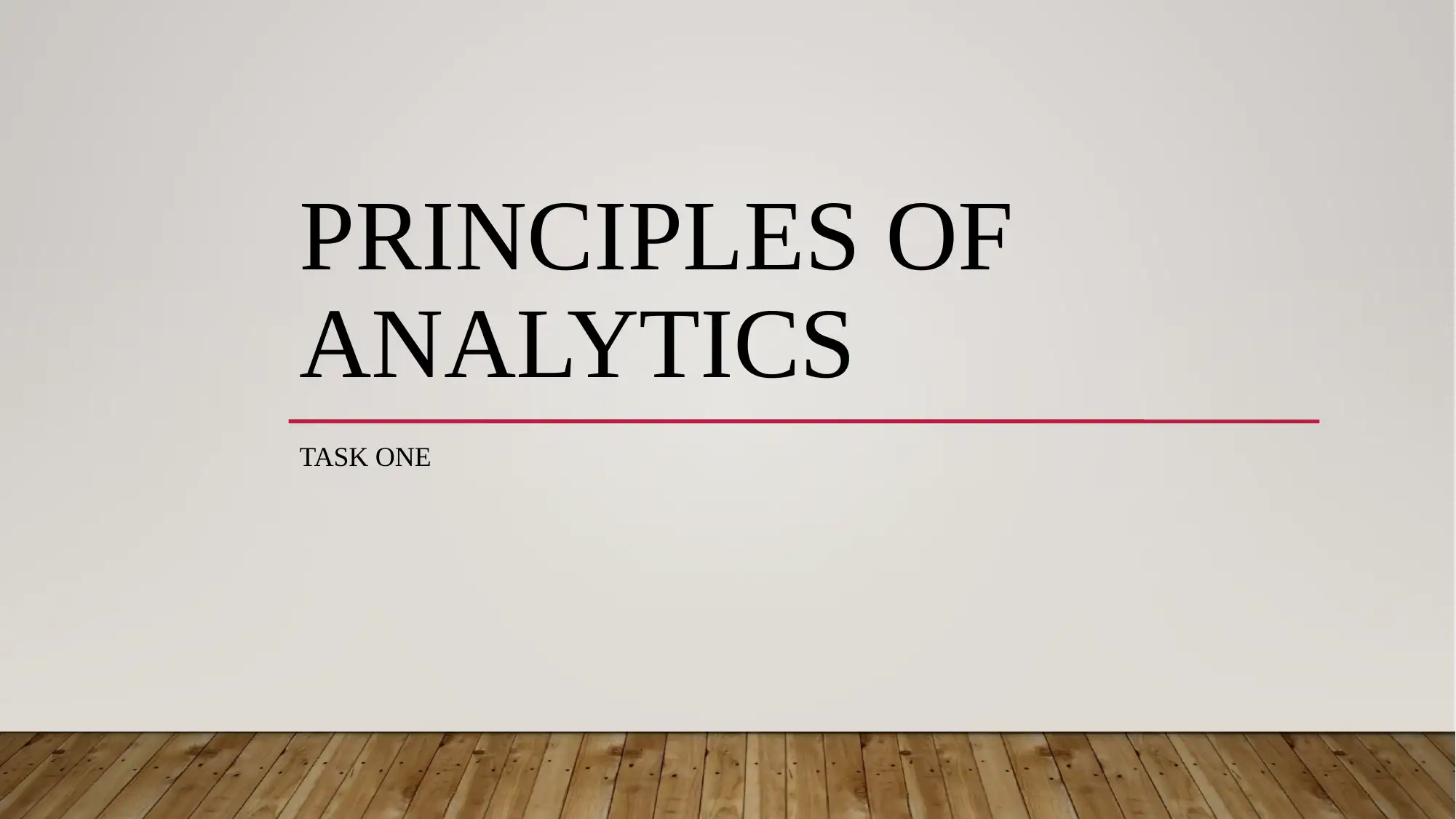
PRINCIPLES OF
ANALYTICS
TASK ONE
ANALYTICS
TASK ONE
Paraphrase This Document
Need a fresh take? Get an instant paraphrase of this document with our AI Paraphraser
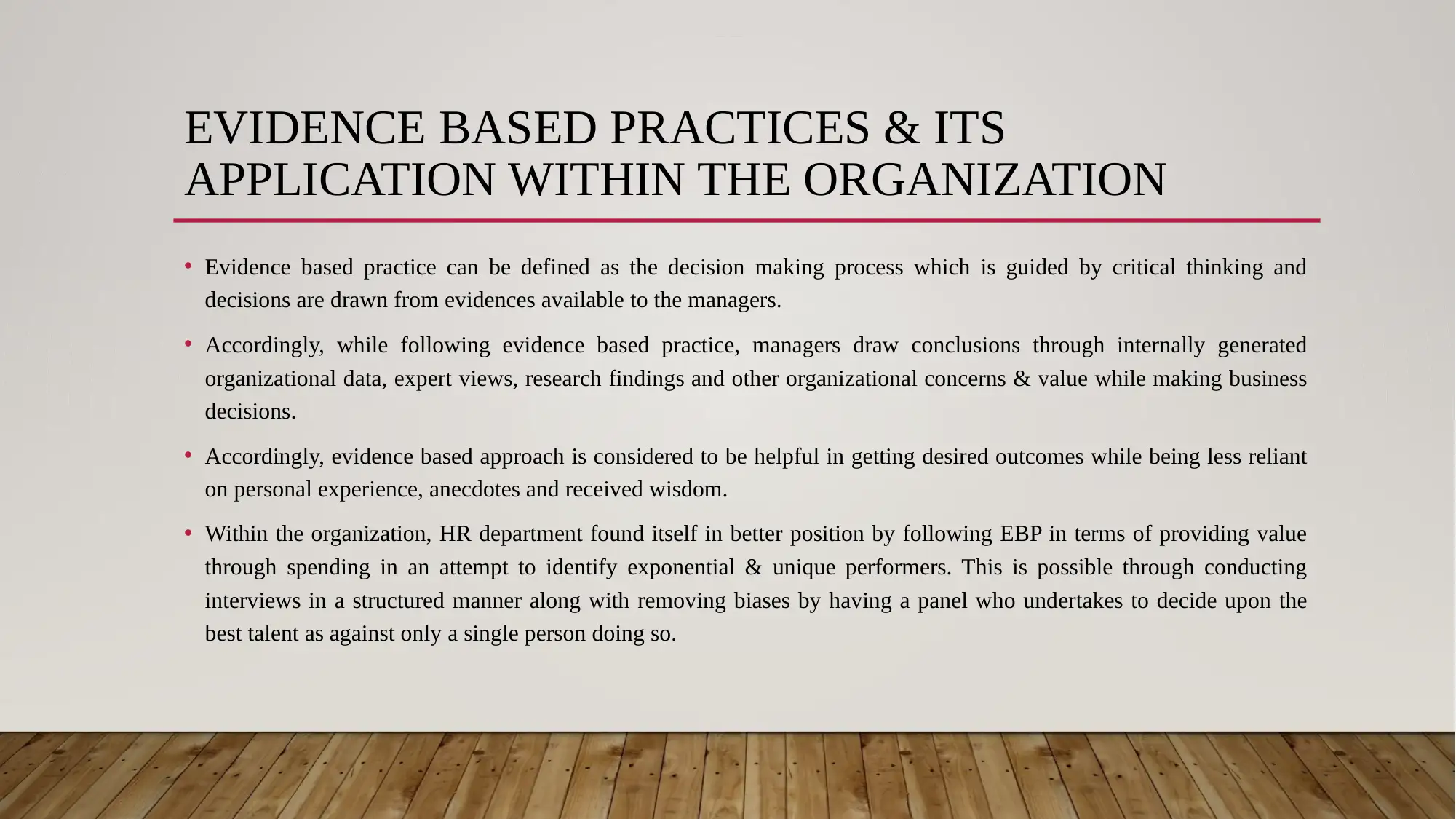
EVIDENCE BASED PRACTICES & ITS
APPLICATION WITHIN THE ORGANIZATION
• Evidence based practice can be defined as the decision making process which is guided by critical thinking and
decisions are drawn from evidences available to the managers.
• Accordingly, while following evidence based practice, managers draw conclusions through internally generated
organizational data, expert views, research findings and other organizational concerns & value while making business
decisions.
• Accordingly, evidence based approach is considered to be helpful in getting desired outcomes while being less reliant
on personal experience, anecdotes and received wisdom.
• Within the organization, HR department found itself in better position by following EBP in terms of providing value
through spending in an attempt to identify exponential & unique performers. This is possible through conducting
interviews in a structured manner along with removing biases by having a panel who undertakes to decide upon the
best talent as against only a single person doing so.
APPLICATION WITHIN THE ORGANIZATION
• Evidence based practice can be defined as the decision making process which is guided by critical thinking and
decisions are drawn from evidences available to the managers.
• Accordingly, while following evidence based practice, managers draw conclusions through internally generated
organizational data, expert views, research findings and other organizational concerns & value while making business
decisions.
• Accordingly, evidence based approach is considered to be helpful in getting desired outcomes while being less reliant
on personal experience, anecdotes and received wisdom.
• Within the organization, HR department found itself in better position by following EBP in terms of providing value
through spending in an attempt to identify exponential & unique performers. This is possible through conducting
interviews in a structured manner along with removing biases by having a panel who undertakes to decide upon the
best talent as against only a single person doing so.
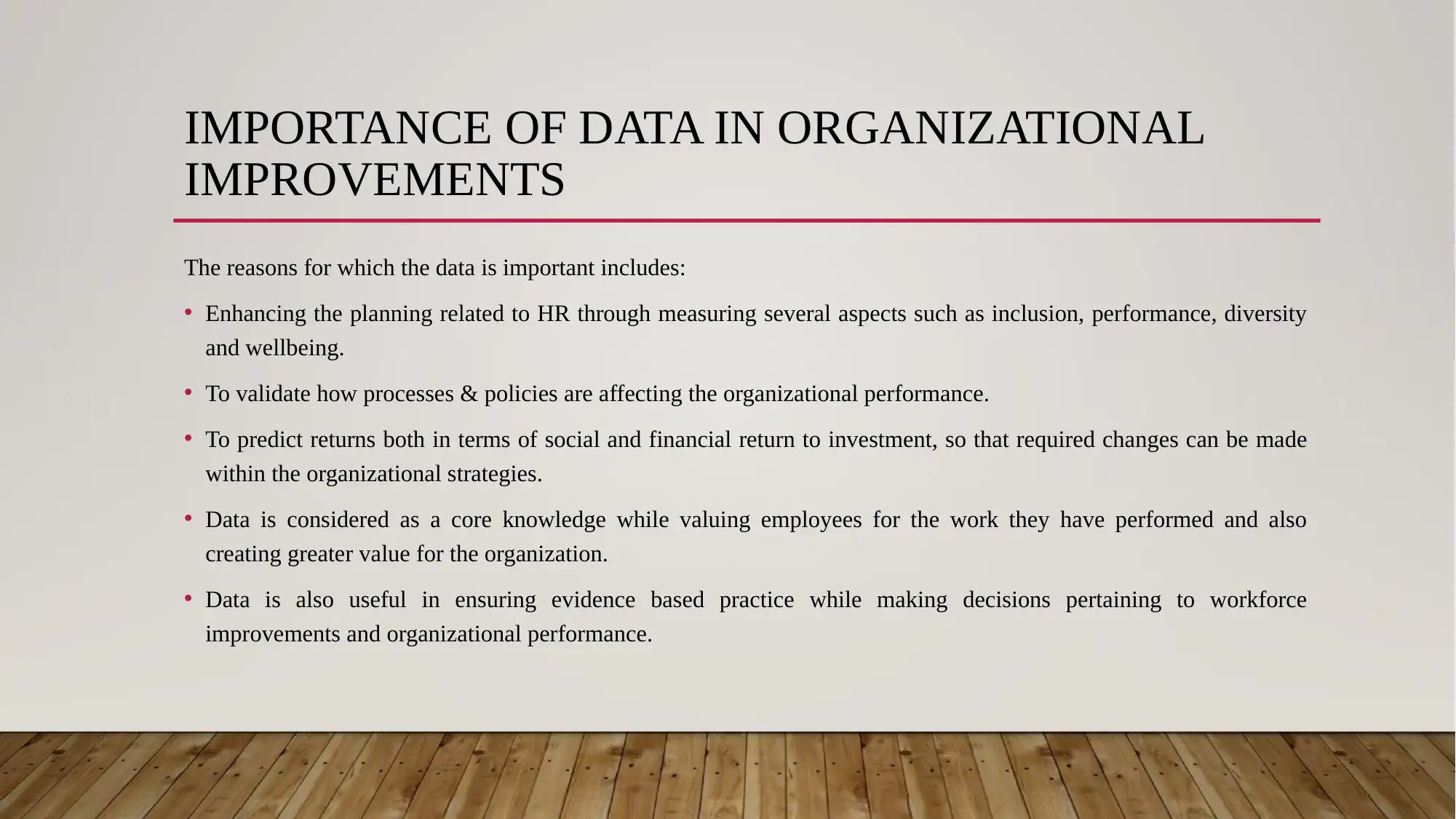
IMPORTANCE OF DATA IN ORGANIZATIONAL
IMPROVEMENTS
The reasons for which the data is important includes:
• Enhancing the planning related to HR through measuring several aspects such as inclusion, performance, diversity
and wellbeing.
• To validate how processes & policies are affecting the organizational performance.
• To predict returns both in terms of social and financial return to investment, so that required changes can be made
within the organizational strategies.
• Data is considered as a core knowledge while valuing employees for the work they have performed and also
creating greater value for the organization.
• Data is also useful in ensuring evidence based practice while making decisions pertaining to workforce
improvements and organizational performance.
IMPROVEMENTS
The reasons for which the data is important includes:
• Enhancing the planning related to HR through measuring several aspects such as inclusion, performance, diversity
and wellbeing.
• To validate how processes & policies are affecting the organizational performance.
• To predict returns both in terms of social and financial return to investment, so that required changes can be made
within the organizational strategies.
• Data is considered as a core knowledge while valuing employees for the work they have performed and also
creating greater value for the organization.
• Data is also useful in ensuring evidence based practice while making decisions pertaining to workforce
improvements and organizational performance.
⊘ This is a preview!⊘
Do you want full access?
Subscribe today to unlock all pages.

Trusted by 1+ million students worldwide
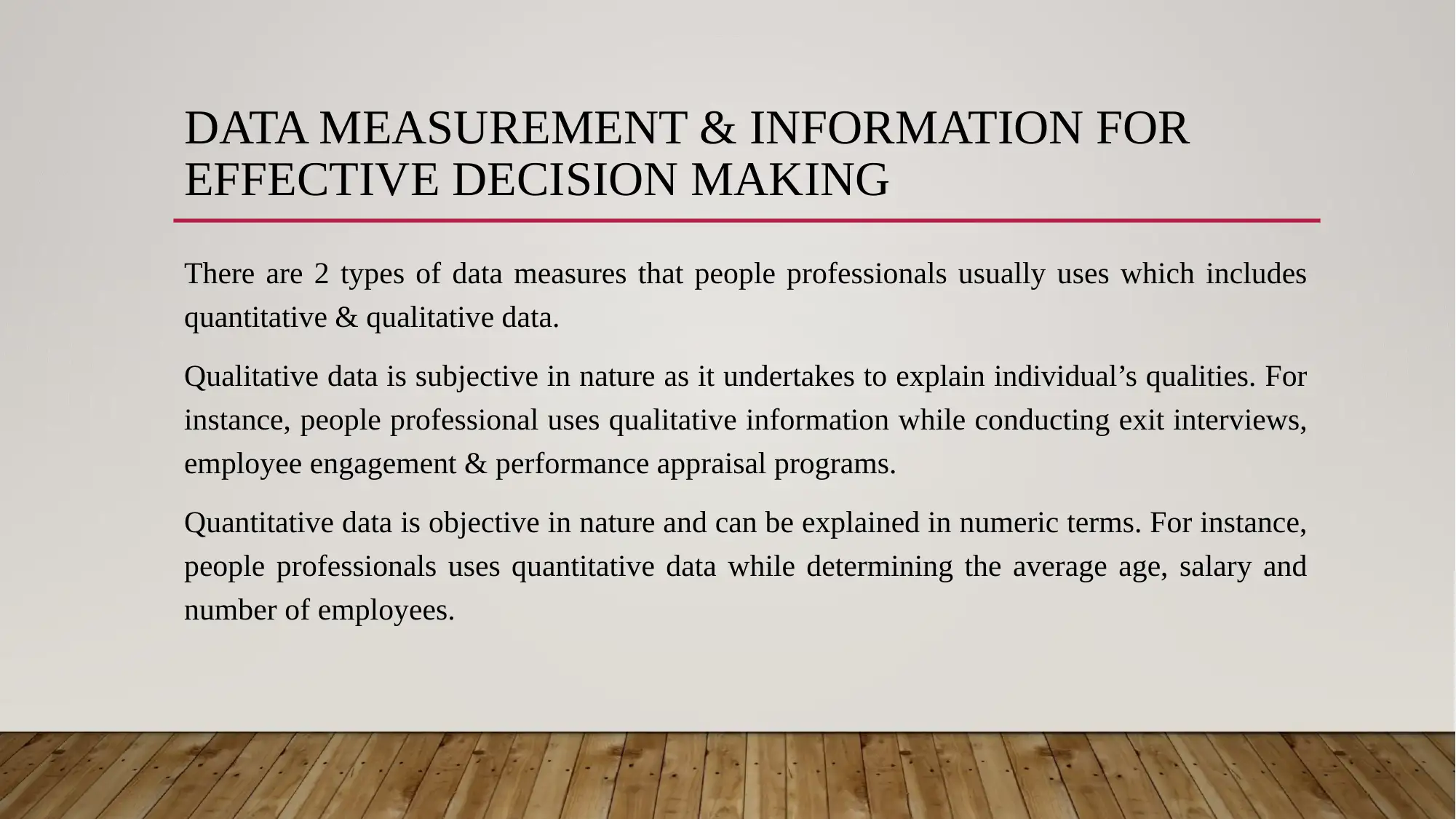
DATA MEASUREMENT & INFORMATION FOR
EFFECTIVE DECISION MAKING
There are 2 types of data measures that people professionals usually uses which includes
quantitative & qualitative data.
Qualitative data is subjective in nature as it undertakes to explain individual’s qualities. For
instance, people professional uses qualitative information while conducting exit interviews,
employee engagement & performance appraisal programs.
Quantitative data is objective in nature and can be explained in numeric terms. For instance,
people professionals uses quantitative data while determining the average age, salary and
number of employees.
EFFECTIVE DECISION MAKING
There are 2 types of data measures that people professionals usually uses which includes
quantitative & qualitative data.
Qualitative data is subjective in nature as it undertakes to explain individual’s qualities. For
instance, people professional uses qualitative information while conducting exit interviews,
employee engagement & performance appraisal programs.
Quantitative data is objective in nature and can be explained in numeric terms. For instance,
people professionals uses quantitative data while determining the average age, salary and
number of employees.
Paraphrase This Document
Need a fresh take? Get an instant paraphrase of this document with our AI Paraphraser
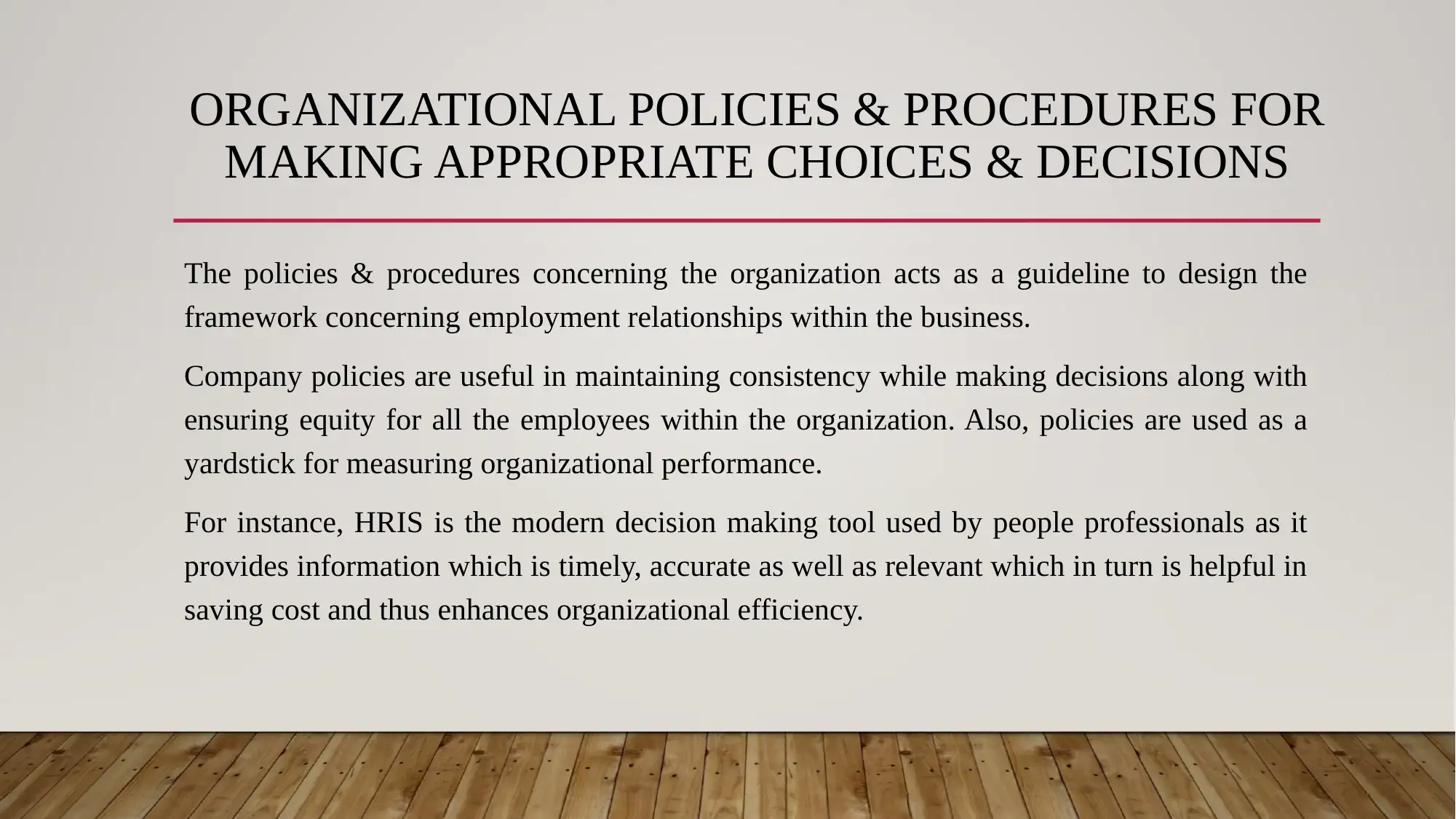
ORGANIZATIONAL POLICIES & PROCEDURES FOR
MAKING APPROPRIATE CHOICES & DECISIONS
The policies & procedures concerning the organization acts as a guideline to design the
framework concerning employment relationships within the business.
Company policies are useful in maintaining consistency while making decisions along with
ensuring equity for all the employees within the organization. Also, policies are used as a
yardstick for measuring organizational performance.
For instance, HRIS is the modern decision making tool used by people professionals as it
provides information which is timely, accurate as well as relevant which in turn is helpful in
saving cost and thus enhances organizational efficiency.
MAKING APPROPRIATE CHOICES & DECISIONS
The policies & procedures concerning the organization acts as a guideline to design the
framework concerning employment relationships within the business.
Company policies are useful in maintaining consistency while making decisions along with
ensuring equity for all the employees within the organization. Also, policies are used as a
yardstick for measuring organizational performance.
For instance, HRIS is the modern decision making tool used by people professionals as it
provides information which is timely, accurate as well as relevant which in turn is helpful in
saving cost and thus enhances organizational efficiency.
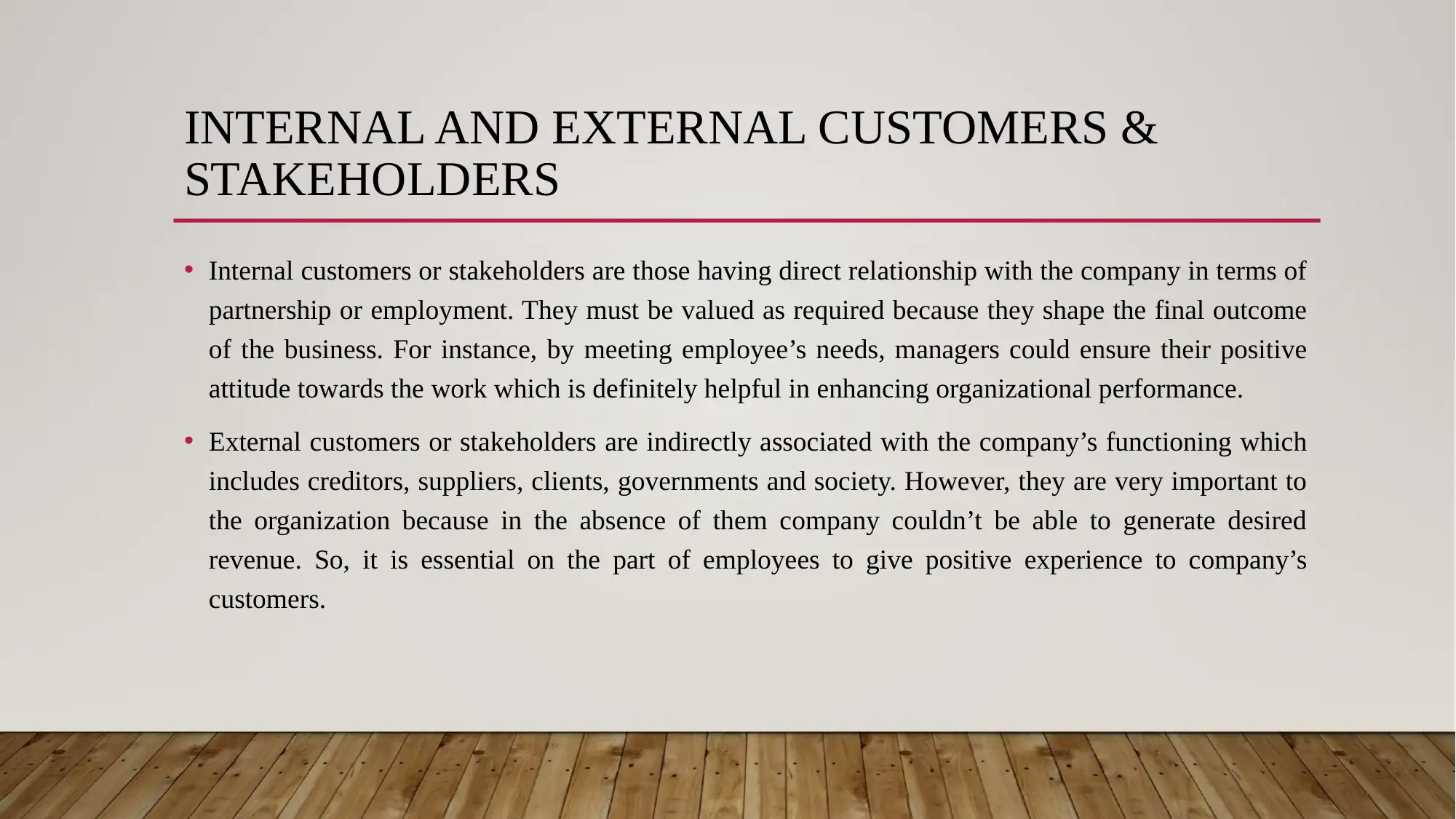
INTERNAL AND EXTERNAL CUSTOMERS &
STAKEHOLDERS
• Internal customers or stakeholders are those having direct relationship with the company in terms of
partnership or employment. They must be valued as required because they shape the final outcome
of the business. For instance, by meeting employee’s needs, managers could ensure their positive
attitude towards the work which is definitely helpful in enhancing organizational performance.
• External customers or stakeholders are indirectly associated with the company’s functioning which
includes creditors, suppliers, clients, governments and society. However, they are very important to
the organization because in the absence of them company couldn’t be able to generate desired
revenue. So, it is essential on the part of employees to give positive experience to company’s
customers.
STAKEHOLDERS
• Internal customers or stakeholders are those having direct relationship with the company in terms of
partnership or employment. They must be valued as required because they shape the final outcome
of the business. For instance, by meeting employee’s needs, managers could ensure their positive
attitude towards the work which is definitely helpful in enhancing organizational performance.
• External customers or stakeholders are indirectly associated with the company’s functioning which
includes creditors, suppliers, clients, governments and society. However, they are very important to
the organization because in the absence of them company couldn’t be able to generate desired
revenue. So, it is essential on the part of employees to give positive experience to company’s
customers.
⊘ This is a preview!⊘
Do you want full access?
Subscribe today to unlock all pages.

Trusted by 1+ million students worldwide
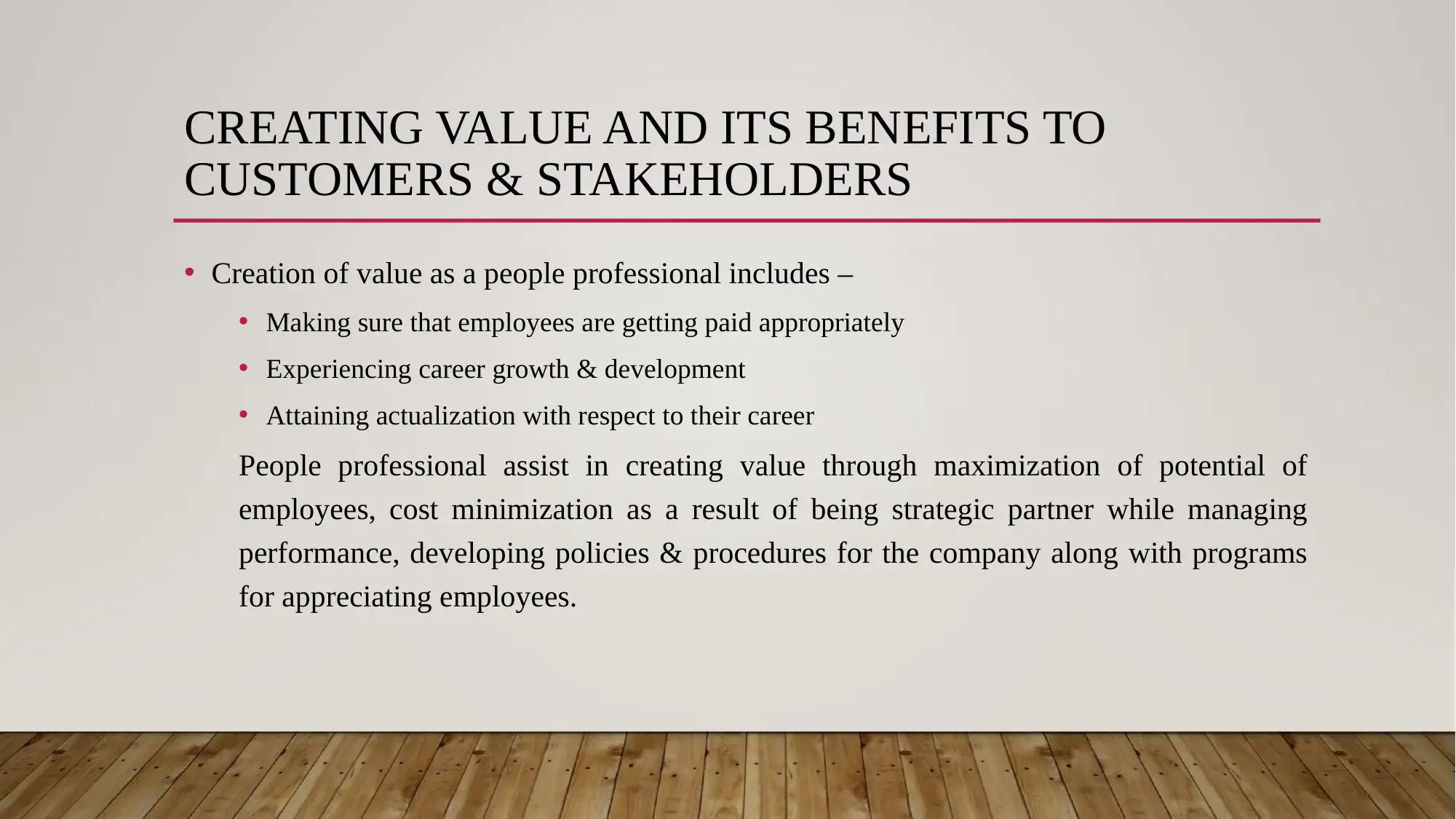
CREATING VALUE AND ITS BENEFITS TO
CUSTOMERS & STAKEHOLDERS
• Creation of value as a people professional includes –
• Making sure that employees are getting paid appropriately
• Experiencing career growth & development
• Attaining actualization with respect to their career
People professional assist in creating value through maximization of potential of
employees, cost minimization as a result of being strategic partner while managing
performance, developing policies & procedures for the company along with programs
for appreciating employees.
CUSTOMERS & STAKEHOLDERS
• Creation of value as a people professional includes –
• Making sure that employees are getting paid appropriately
• Experiencing career growth & development
• Attaining actualization with respect to their career
People professional assist in creating value through maximization of potential of
employees, cost minimization as a result of being strategic partner while managing
performance, developing policies & procedures for the company along with programs
for appreciating employees.
Paraphrase This Document
Need a fresh take? Get an instant paraphrase of this document with our AI Paraphraser
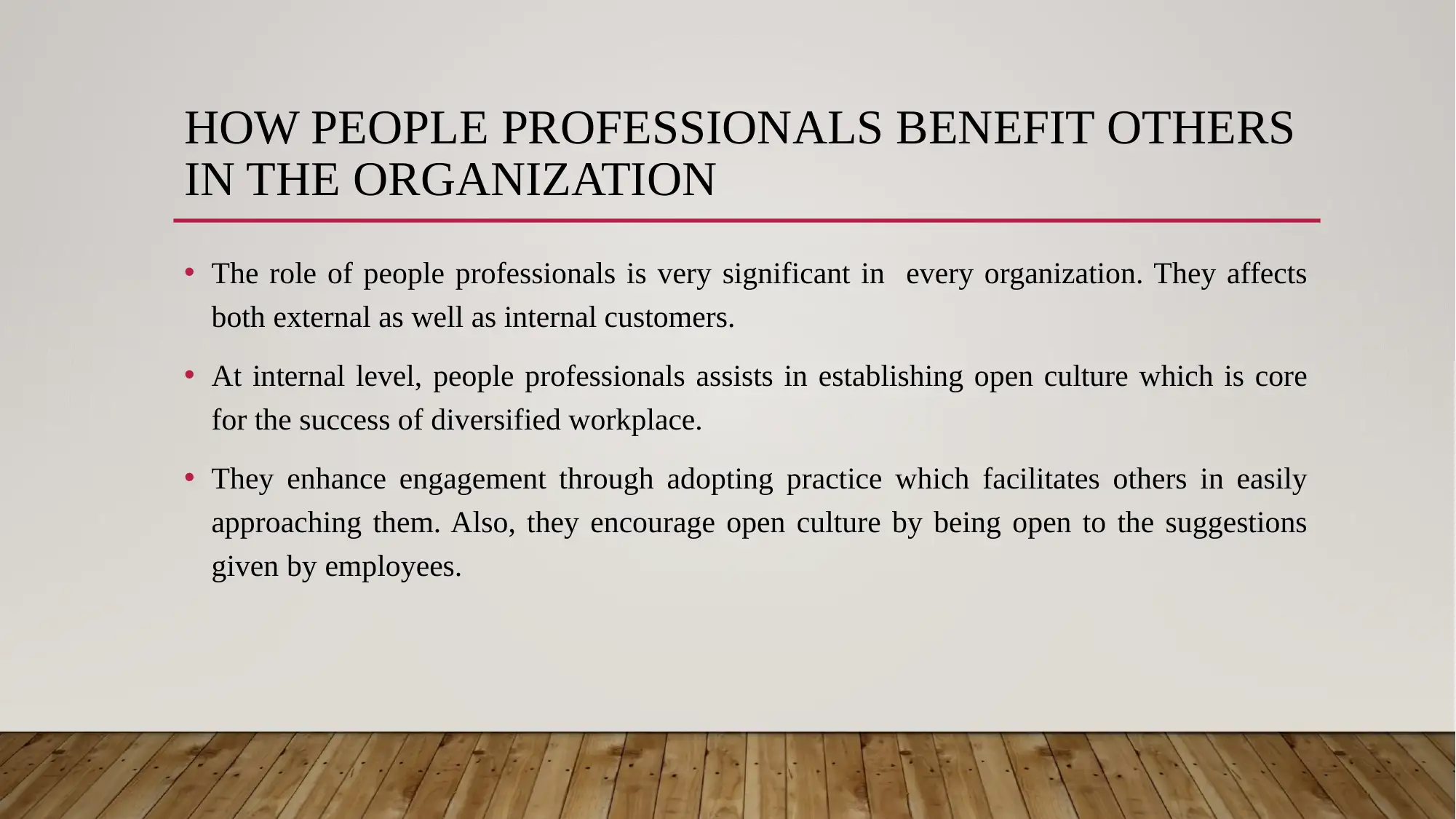
HOW PEOPLE PROFESSIONALS BENEFIT OTHERS
IN THE ORGANIZATION
• The role of people professionals is very significant in every organization. They affects
both external as well as internal customers.
• At internal level, people professionals assists in establishing open culture which is core
for the success of diversified workplace.
• They enhance engagement through adopting practice which facilitates others in easily
approaching them. Also, they encourage open culture by being open to the suggestions
given by employees.
IN THE ORGANIZATION
• The role of people professionals is very significant in every organization. They affects
both external as well as internal customers.
• At internal level, people professionals assists in establishing open culture which is core
for the success of diversified workplace.
• They enhance engagement through adopting practice which facilitates others in easily
approaching them. Also, they encourage open culture by being open to the suggestions
given by employees.
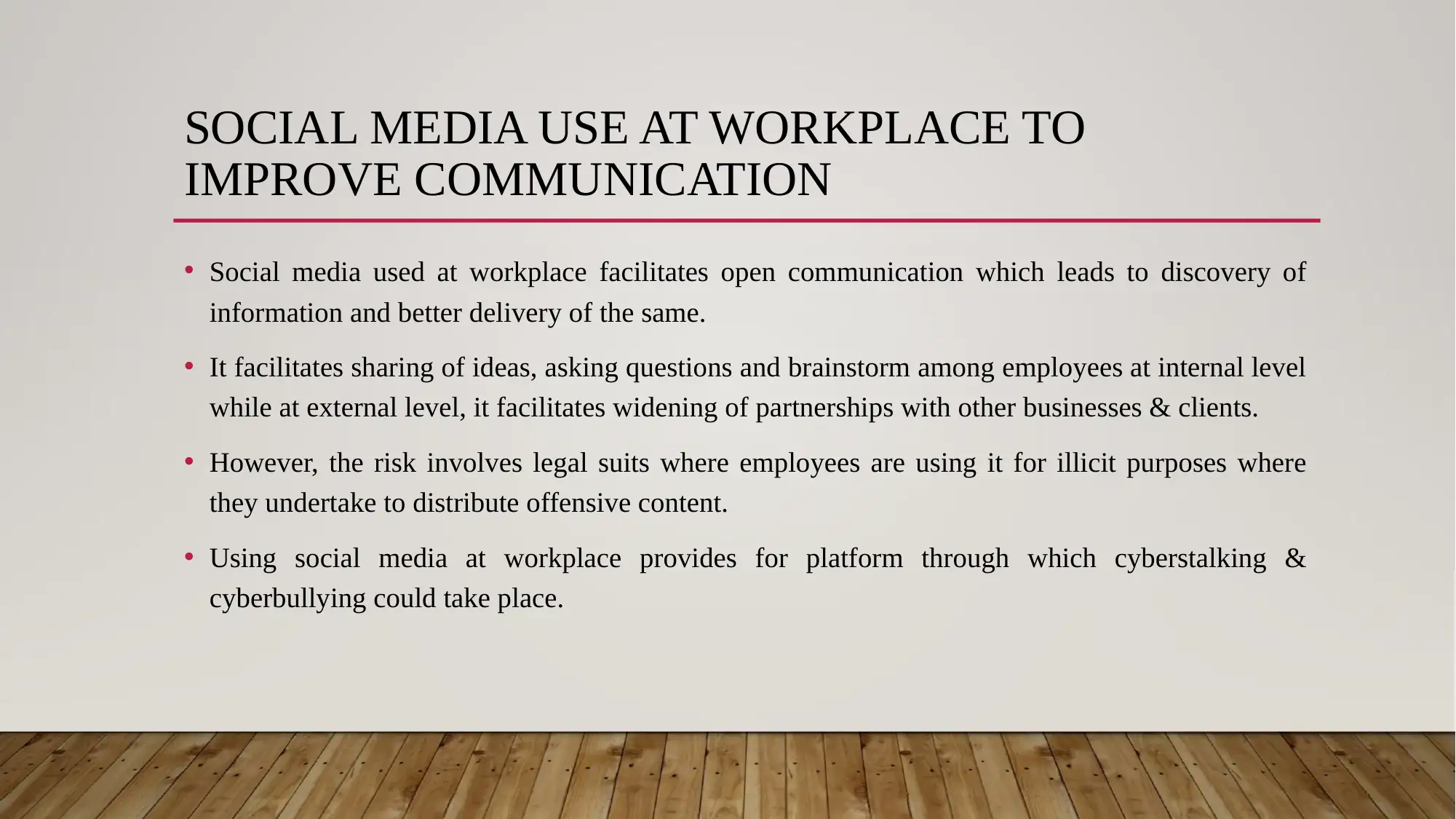
SOCIAL MEDIA USE AT WORKPLACE TO
IMPROVE COMMUNICATION
• Social media used at workplace facilitates open communication which leads to discovery of
information and better delivery of the same.
• It facilitates sharing of ideas, asking questions and brainstorm among employees at internal level
while at external level, it facilitates widening of partnerships with other businesses & clients.
• However, the risk involves legal suits where employees are using it for illicit purposes where
they undertake to distribute offensive content.
• Using social media at workplace provides for platform through which cyberstalking &
cyberbullying could take place.
IMPROVE COMMUNICATION
• Social media used at workplace facilitates open communication which leads to discovery of
information and better delivery of the same.
• It facilitates sharing of ideas, asking questions and brainstorm among employees at internal level
while at external level, it facilitates widening of partnerships with other businesses & clients.
• However, the risk involves legal suits where employees are using it for illicit purposes where
they undertake to distribute offensive content.
• Using social media at workplace provides for platform through which cyberstalking &
cyberbullying could take place.
⊘ This is a preview!⊘
Do you want full access?
Subscribe today to unlock all pages.

Trusted by 1+ million students worldwide
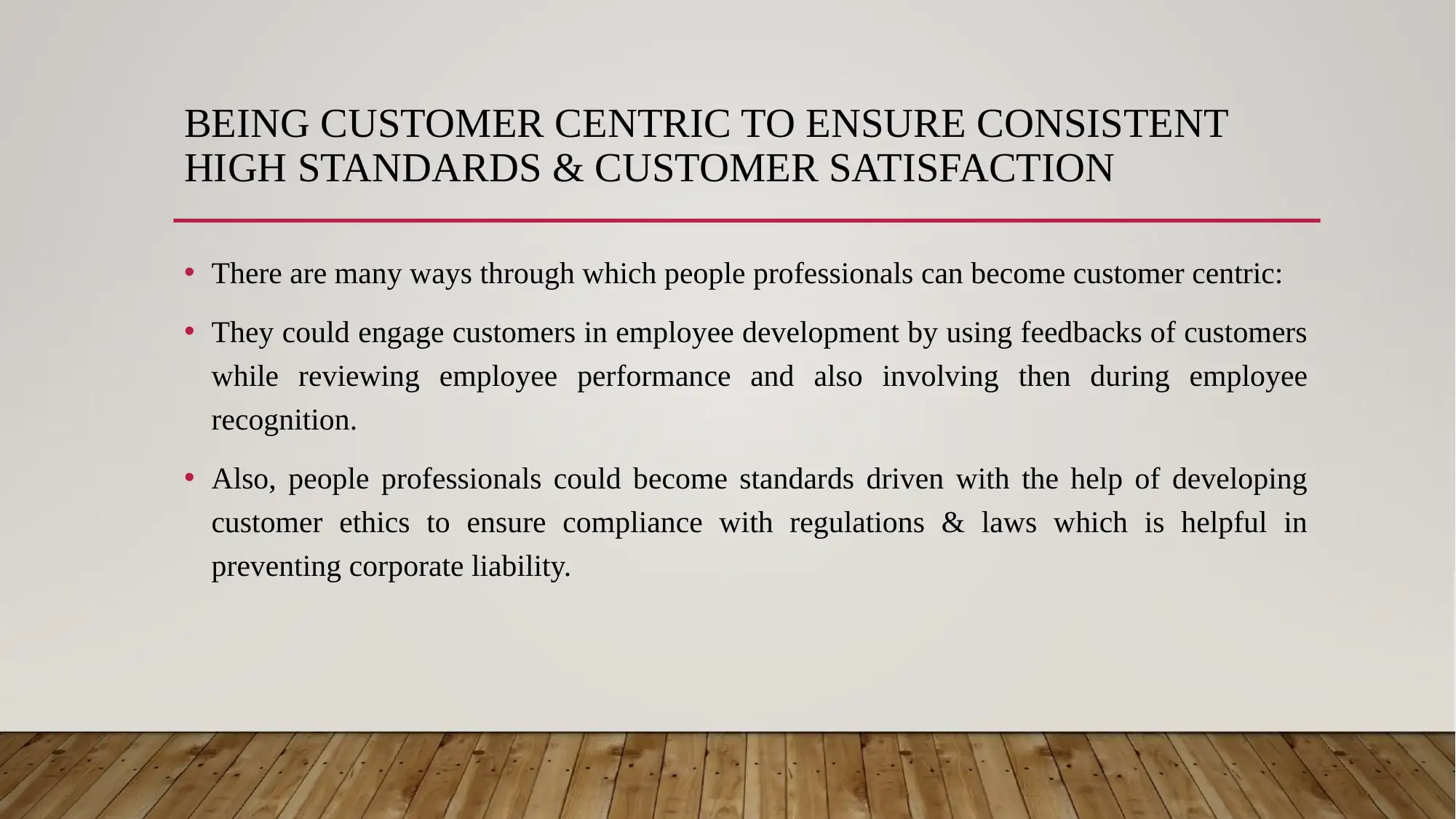
BEING CUSTOMER CENTRIC TO ENSURE CONSISTENT
HIGH STANDARDS & CUSTOMER SATISFACTION
• There are many ways through which people professionals can become customer centric:
• They could engage customers in employee development by using feedbacks of customers
while reviewing employee performance and also involving then during employee
recognition.
• Also, people professionals could become standards driven with the help of developing
customer ethics to ensure compliance with regulations & laws which is helpful in
preventing corporate liability.
HIGH STANDARDS & CUSTOMER SATISFACTION
• There are many ways through which people professionals can become customer centric:
• They could engage customers in employee development by using feedbacks of customers
while reviewing employee performance and also involving then during employee
recognition.
• Also, people professionals could become standards driven with the help of developing
customer ethics to ensure compliance with regulations & laws which is helpful in
preventing corporate liability.
Paraphrase This Document
Need a fresh take? Get an instant paraphrase of this document with our AI Paraphraser
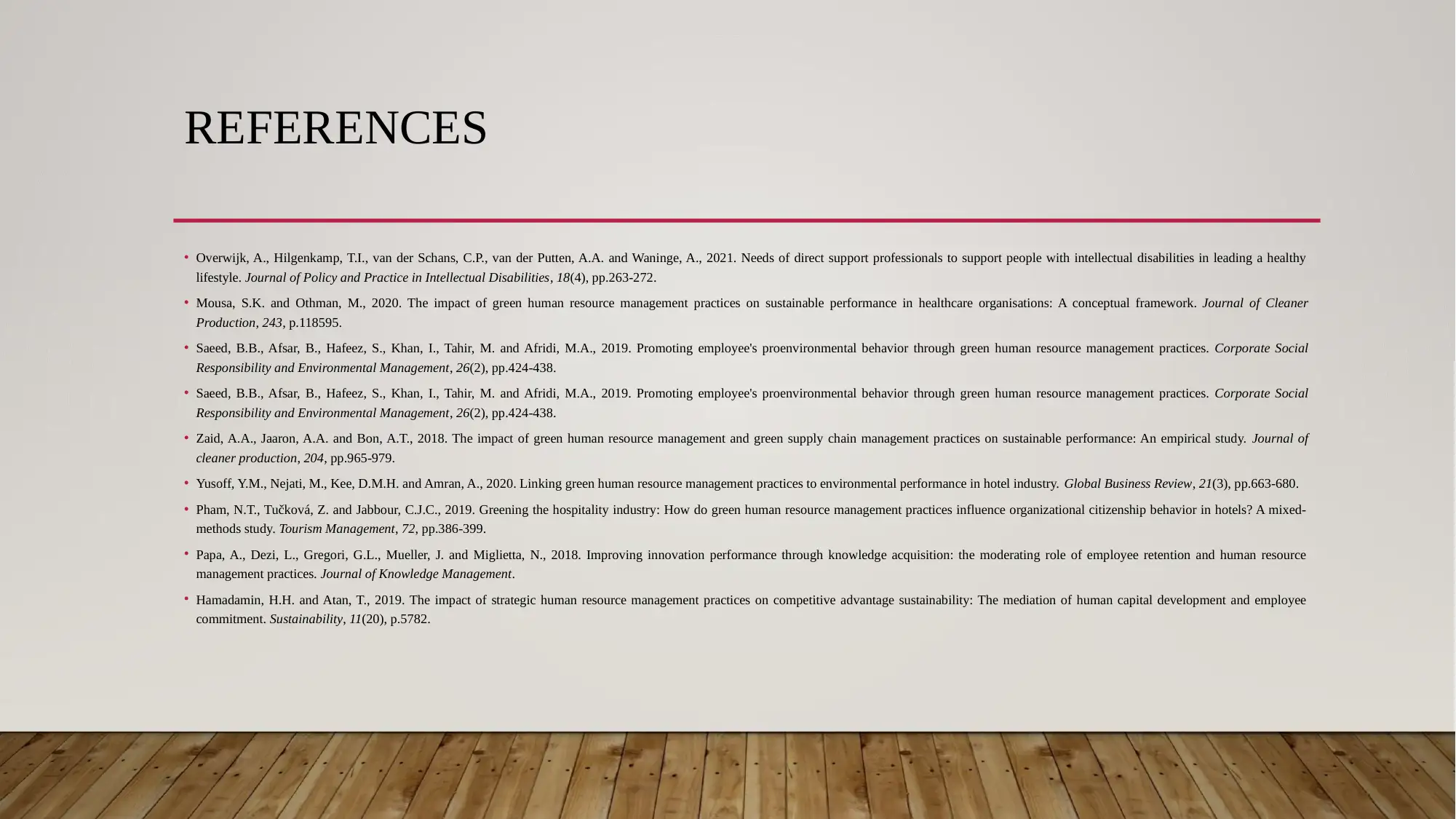
REFERENCES
• Overwijk, A., Hilgenkamp, T.I., van der Schans, C.P., van der Putten, A.A. and Waninge, A., 2021. Needs of direct support professionals to support people with intellectual disabilities in leading a healthy
lifestyle. Journal of Policy and Practice in Intellectual Disabilities, 18(4), pp.263-272.
• Mousa, S.K. and Othman, M., 2020. The impact of green human resource management practices on sustainable performance in healthcare organisations: A conceptual framework. Journal of Cleaner
Production, 243, p.118595.
• Saeed, B.B., Afsar, B., Hafeez, S., Khan, I., Tahir, M. and Afridi, M.A., 2019. Promoting employee's proenvironmental behavior through green human resource management practices. Corporate Social
Responsibility and Environmental Management, 26(2), pp.424-438.
• Saeed, B.B., Afsar, B., Hafeez, S., Khan, I., Tahir, M. and Afridi, M.A., 2019. Promoting employee's proenvironmental behavior through green human resource management practices. Corporate Social
Responsibility and Environmental Management, 26(2), pp.424-438.
• Zaid, A.A., Jaaron, A.A. and Bon, A.T., 2018. The impact of green human resource management and green supply chain management practices on sustainable performance: An empirical study. Journal of
cleaner production, 204, pp.965-979.
• Yusoff, Y.M., Nejati, M., Kee, D.M.H. and Amran, A., 2020. Linking green human resource management practices to environmental performance in hotel industry. Global Business Review, 21(3), pp.663-680.
• Pham, N.T., Tučková, Z. and Jabbour, C.J.C., 2019. Greening the hospitality industry: How do green human resource management practices influence organizational citizenship behavior in hotels? A mixed-
methods study. Tourism Management, 72, pp.386-399.
• Papa, A., Dezi, L., Gregori, G.L., Mueller, J. and Miglietta, N., 2018. Improving innovation performance through knowledge acquisition: the moderating role of employee retention and human resource
management practices. Journal of Knowledge Management.
• Hamadamin, H.H. and Atan, T., 2019. The impact of strategic human resource management practices on competitive advantage sustainability: The mediation of human capital development and employee
commitment. Sustainability, 11(20), p.5782.
• Overwijk, A., Hilgenkamp, T.I., van der Schans, C.P., van der Putten, A.A. and Waninge, A., 2021. Needs of direct support professionals to support people with intellectual disabilities in leading a healthy
lifestyle. Journal of Policy and Practice in Intellectual Disabilities, 18(4), pp.263-272.
• Mousa, S.K. and Othman, M., 2020. The impact of green human resource management practices on sustainable performance in healthcare organisations: A conceptual framework. Journal of Cleaner
Production, 243, p.118595.
• Saeed, B.B., Afsar, B., Hafeez, S., Khan, I., Tahir, M. and Afridi, M.A., 2019. Promoting employee's proenvironmental behavior through green human resource management practices. Corporate Social
Responsibility and Environmental Management, 26(2), pp.424-438.
• Saeed, B.B., Afsar, B., Hafeez, S., Khan, I., Tahir, M. and Afridi, M.A., 2019. Promoting employee's proenvironmental behavior through green human resource management practices. Corporate Social
Responsibility and Environmental Management, 26(2), pp.424-438.
• Zaid, A.A., Jaaron, A.A. and Bon, A.T., 2018. The impact of green human resource management and green supply chain management practices on sustainable performance: An empirical study. Journal of
cleaner production, 204, pp.965-979.
• Yusoff, Y.M., Nejati, M., Kee, D.M.H. and Amran, A., 2020. Linking green human resource management practices to environmental performance in hotel industry. Global Business Review, 21(3), pp.663-680.
• Pham, N.T., Tučková, Z. and Jabbour, C.J.C., 2019. Greening the hospitality industry: How do green human resource management practices influence organizational citizenship behavior in hotels? A mixed-
methods study. Tourism Management, 72, pp.386-399.
• Papa, A., Dezi, L., Gregori, G.L., Mueller, J. and Miglietta, N., 2018. Improving innovation performance through knowledge acquisition: the moderating role of employee retention and human resource
management practices. Journal of Knowledge Management.
• Hamadamin, H.H. and Atan, T., 2019. The impact of strategic human resource management practices on competitive advantage sustainability: The mediation of human capital development and employee
commitment. Sustainability, 11(20), p.5782.
1 out of 11
Related Documents
Your All-in-One AI-Powered Toolkit for Academic Success.
+13062052269
info@desklib.com
Available 24*7 on WhatsApp / Email
![[object Object]](/_next/static/media/star-bottom.7253800d.svg)
Unlock your academic potential
Copyright © 2020–2025 A2Z Services. All Rights Reserved. Developed and managed by ZUCOL.





